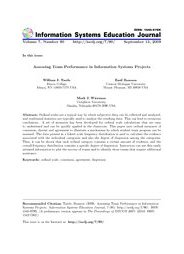Volume 7
Volume 7, Number 90 |
September 15, 2009 |
Abstract: Ordinal scales are a typical way by which subjective data can be collected and analyzed, and traditional statistics are typically used to analyze the resulting data. This can lead to erroneous conclusions. A set of measures has been developed for ordinal scale calculations that are easy to understand and can be quickly applied in the classroom. This paper uses ordinal measures of consensus, dissent and agreement to illustrate a mechanism by which student team progress can be assessed. The data present in a Likert scale frequency distribution is used to calculate the evidence associated with the individual categories and also the degree of dispersion among the categories. Thus, it can be shown that each ordinal category contains a certain amount of evidence, and the overall frequency distribution contains a specific degree of dispersion. Instructors can use this easily attained information to plot the success of teams and to identify those teams that require additional assistance.
Keywords: ordinal scale, consensus, agreement, dispersion
Download this issue: ISEDJ.7(90).Tastle.pdf (Adobe PDF, 10 pages, 590 K bytes)
Preview the contents: Tastle.j.txt (ASCII txt, 22 K bytes)
Recommended Citation: Tastle, Boasson (2009). Assessing Team Performance in Information Systems Projects. Information Systems Education Journal, 7 (90). http://isedj.org/7/90/. ISSN: 1545-679X. (A preliminary version appears in The Proceedings of ISECON 2007: §2344. ISSN: 1542-7382.)
